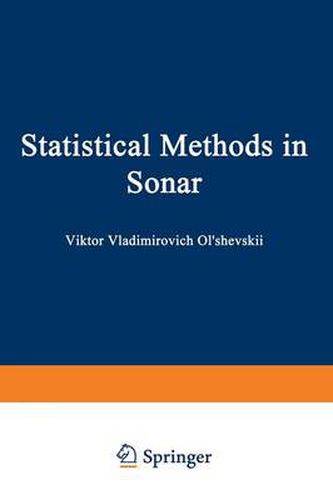Readings Newsletter
Become a Readings Member to make your shopping experience even easier.
Sign in or sign up for free!
You’re not far away from qualifying for FREE standard shipping within Australia
You’ve qualified for FREE standard shipping within Australia
The cart is loading…






This title is printed to order. This book may have been self-published. If so, we cannot guarantee the quality of the content. In the main most books will have gone through the editing process however some may not. We therefore suggest that you be aware of this before ordering this book. If in doubt check either the author or publisher’s details as we are unable to accept any returns unless they are faulty. Please contact us if you have any questions.
Dr. V. V. Ol'shevskii is perhaps most familiar to Western readers as the author of Characteristics of Sea Reverberation, published in translation by Consultants Bureau (New York, 1967). The present book, Statistical Methods in Sonar, is, in part, a sequel to the first book, where now the author’s stated purpose is to acquaint a broad range of specialists with the use of contemporary statistical methods for solving theoretical and applied sonar problems.
As the author quite properly observes, the work is illustrative, devoted to a variety of relevant, specific technical problems from an analytical point of view, and is not in any way intended to be an all-inclusive treatise. Nevertheless, as the reader can verify subse quently, the author has succeeded in accomplishing his stated purpose. He has, moreover. provided us with a use ful and, in a number of instances, provocative work, which even five years after its original appearance retains its freshness and interest with material not to date covered in other books on the subject (for example, see Horton [~Q], Stephens [41] ). * In this Foreword we first concisely review the author’s material, on a chapter-by-chapter basis, after which a short general critique is given. Attention is called to various topics of particular interest to the professional audience. as well as to a number of highlights which deserve the reader’s notice (a few additional comments on the technical editing are then included).
$9.00 standard shipping within Australia
FREE standard shipping within Australia for orders over $100.00
Express & International shipping calculated at checkout
This title is printed to order. This book may have been self-published. If so, we cannot guarantee the quality of the content. In the main most books will have gone through the editing process however some may not. We therefore suggest that you be aware of this before ordering this book. If in doubt check either the author or publisher’s details as we are unable to accept any returns unless they are faulty. Please contact us if you have any questions.
Dr. V. V. Ol'shevskii is perhaps most familiar to Western readers as the author of Characteristics of Sea Reverberation, published in translation by Consultants Bureau (New York, 1967). The present book, Statistical Methods in Sonar, is, in part, a sequel to the first book, where now the author’s stated purpose is to acquaint a broad range of specialists with the use of contemporary statistical methods for solving theoretical and applied sonar problems.
As the author quite properly observes, the work is illustrative, devoted to a variety of relevant, specific technical problems from an analytical point of view, and is not in any way intended to be an all-inclusive treatise. Nevertheless, as the reader can verify subse quently, the author has succeeded in accomplishing his stated purpose. He has, moreover. provided us with a use ful and, in a number of instances, provocative work, which even five years after its original appearance retains its freshness and interest with material not to date covered in other books on the subject (for example, see Horton [~Q], Stephens [41] ). * In this Foreword we first concisely review the author’s material, on a chapter-by-chapter basis, after which a short general critique is given. Attention is called to various topics of particular interest to the professional audience. as well as to a number of highlights which deserve the reader’s notice (a few additional comments on the technical editing are then included).